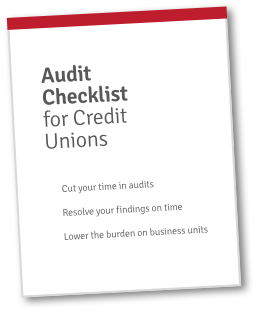For most credit unions, repeat findings are an unfortunate but occasional occurrence. Sometimes, the corrective action you took on non-conforming findings didn’t stick. And sometimes, findings take longer to address, or an item gets missed on a spreadsheet, or an email gets buried in an inbox…
And things fall through the cracks. Suddenly, an overdue finding goes unresolved.
So what happens when that unresolved finding shows up again in the next audit? It’s reason for concern, but probably not reason to panic.
Here are a few things you can do to handle repeat audit findings at your credit union. Fortunately, you’re probably already doing some of them.
Want to prevent overdue, unresolved, and repeat findings altogether? Download our free Unresolved Findings Eliminator worksheet!
What Are Repeat Findings inAudits?
A quick review of what repeat findings are:
When your auditors finish an audit, they’ll hand you a list of findings. Those findings are general observations about your policies, processes, and procedures. There are two kinds of findings:
- Conforming
- Non-conforming
Conforming findings show that you’re doing everything the way you’re supposed to. Non-conforming findings show areas that don’t meet standards or regulations.
Non-conforming findings come with recommendations for corrective action. If the corrective action didn’t correct the issue, or if that finding went unresolved, then you’ll eventually have a larger issue to deal with:
A repeat finding.
How to Handle Non-Conforming Audit Findings
Handling any non-conforming audit finding is relatively simple. Your auditors make it easy by telling you what’s wrong, what “right” looks like, and how to get there.
Your audit team should have a robust process and workflow in place to manage your findings. Going from finding, to response, to resolution should follow the same thorough steps each time.
Download our free Unresolved Findings Eliminator to see what that process looks like.
Your response should include your audit team and management. As you move into remediation—addressing the finding(s)—you’ll need to ensure that any actions occur on time, as expected, and that everyone stays accountable.
You’ll also want a validation process to guarantee the appropriate actions were taken before you close out the finding. If you don’t have a validation process, you’ll probably get repeat findings.
Dealing with Repeat Findings
Repeat audit findings aren’t much different than regular findings. Here are two steps to resolve those repeat non-conforming findings:
- Take extra care with repeat findings. Flag it as a repeat and be sure to resolve it as requested. Then, extend that same level of intensity and scrutiny to your other non-conforming findings.
- Adjust your audit process if overdue, unresolved, or repeat findings are common. If these issues are occurring often, you should consider altering your approach.
Sometimes things slip through the cracks. Sometimes, in a 12–18-month period, a new hire wasn’t trained properly, and a resolved problem reappeared. So long as your normal audit process is sound, you won’t need to change much to ensure continued success.
However, if you’re seeing a lot of repeat findings, it might be time to reevaluate your audit process, including your structure, your communication strategy, and the role of business units.
Additional Resources for Preventing Repeat Findings
We’ve created a few free useful resources to help credit unions prevent repeat audit findings. We highly recommend downloading them here:


 Get FREE Access to the Audit Checklist for Credit Unions!
Get FREE Access to the Audit Checklist for Credit Unions!


